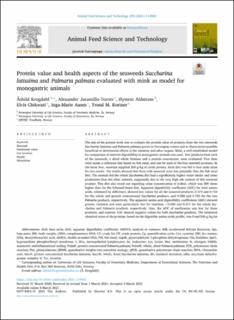| dc.description.abstract | The aim of the present work was to evaluate the protein value of products from the two seaweeds Saccharina latissima and Palmaria palmata grown in Norwegian waters and to characterize possible beneficial or detrimental effects in the intestine and other organs. Mink, a well-established model for comparison of nutrient digestibility in monogastric animals was used. Two products from each of the seaweeds, a dried whole biomass and a protein concentrate, were evaluated. Five diets were made; a reference diet based on fish meal, and one for each of the four seaweed products. In the latter four, seaweed supplied 200 g/kg of crude protein. Each diet was fed to four male mink for two weeks. The results showed that diets with seaweed were less palatable than the fish meal diet. The animals fed the whole Saccharina diet had a significantly higher water intake and urine production than the other animals, supposedly due to the very high ash content of this seaweed product. This diet also stood out regarding urine concentration of iodine, which was 300 times higher than for the fishmeal-based diet. Apparent digestibility coefficient (ADC) for total amino acids, estimated by difference, showed low values for all the seaweed products; 0.574 and 0.734 for the whole and protein concentrated Saccharina products, and 0.588 and 0.700 for the two Palmaria products, respectively. The apparent amino acid digestibility coefficients (ADC) showed greater variation and were particularly low for histidine, <0.000 and 0.271 for the whole Saccharina and Palmaria products, respectively. Also, the ADC of methionine was low for these products, and cysteine ADC showed negative values for both Saccharina products. The estimated chemical score of the proteins, based on the digestible amino acids profile, was 0 and 520 g/kg for the whole product and protein concentrate of Saccharina, 260 and 520 g/kg for the whole product and the protein concentrate of Palmaria palmata, respectively. Expression of genes associated with digestive and immune functions showed minor effects in the jejunum, somewhat more pronounced effects in the colon. The latter effects were related to immune functions and lipid metabolism. No diet-related alterations in the histology of the jejunum and colon were observed. The histological investigation of liver and kidney structure showed some alterations in the seaweed fed animals. Regarding microbiota assemblage in mucosa of jejunum and colon, no clear diet effects were observed either in richness or diversity. In conclusion: the biological value of the seaweed proteins was low. Only one of the products, the Palmaria protein concentrate, might be considered of any use as a protein source. No clear beneficial or detrimental effects of the seaweed products were observed on gut health and function. The results regarding kidney structure and function, as well as the high iodine in the urine, indicating that further investigations are required to secure that animal health is not challenged by use of these seaweed ingredients in animal diets. | en_US |

